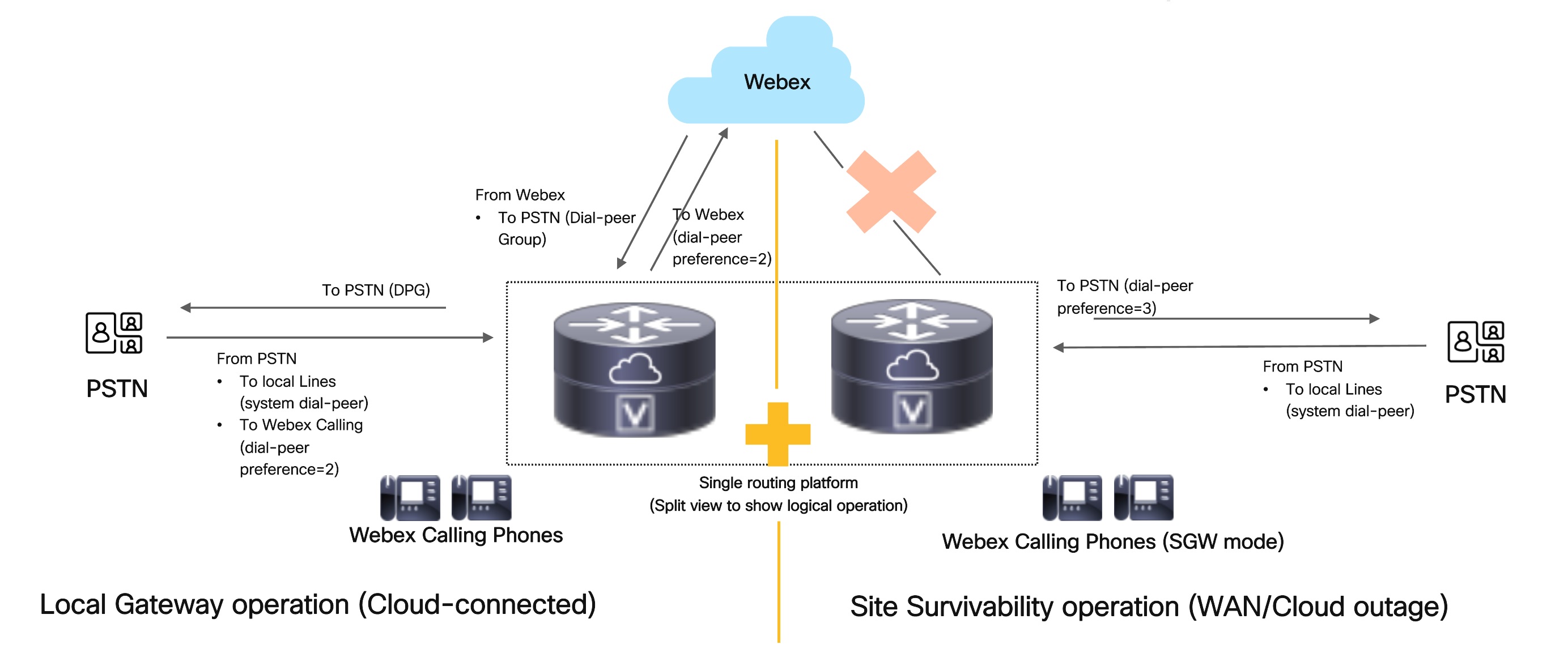- 主页
- /
- 文章


在Cisco IOS托管网关上本地网关和站点生存能力
 在此文章中
在此文章中 反馈?
反馈?作为管理员,请使用此文章了解Cisco IOS托管网关上的本地网关和生存网关服务的共同位置。
概览
Webex Calling支持在同一个Cisco IOS托管网关上本地网关的Survivability网关。也就是说,您可以使用相同的Cisco IOS网关设备配置本地网关和生存网关服务。因此,您无需将两个不同的Cisco IOS托管网关分配为生存性网关和本地网关。
本文讨论与独立部署本地网关和生存网关服务相比较的考虑因素。
-
有关独立本地网关服务的信息,请参阅在Cisco IOS XE for Webex呼叫配置本地网关 和将Cisco IOS托管网关注册到Webex Cloud。
-
有关独立生存网关服务的信息,请参阅 Webex呼叫站点生存能力。
-
平台支持的注册总数是电话和后台注册的总和。此外,预计不会同时进行线路和干线注册。因此,在单个设备上将这些功能并置不会影响生存网关或本地网关的规模。
由于检测到的漏洞,Webex 将于2024年9月1日停用站点存活解决方案使用的RSAES-PKCS1-v1_5加密方案。在此日期之后,RSAES-OAEP加密方案为强制。
要确保继续使用此加密方案,请在2024年9月1日之前将站点存活网关升级至Cisco IOS XE Dublin 17.12.3。在此次升级后,无需更改配置即可使用新的加密方案。
必要条件
Cisco IOS XE Dublin 17.12.3及更高版本。
限制和限制
以下是Cisco IOS托管网关中共享服务的已知限制:
-
本地网关不支持高可用性。
-
本地网关不支持配置验证。
-
在Control Hub中,网关必须配置为生存网关服务。
-
如果客户已将网关配置为本地网关,他们需要取消分配,然后将服务重新分配为生存网关。
-
托管是特定于Cisco IOS网关。使用第三方本地网关的客户必须单独部署Survivability Gateway。
-
在多个客户之间共享的合作伙伴部署的本地网关的共处位置不适用。
有关独立网关服务的特定限制和限制,请参阅将Cisco IOS托管网关注册到Webex云端 和Webex呼叫的站点生存能力。
呼叫路由注意事项
共享位置的呼叫路由基于路由策略,涉及拨号对等组(DPG)和基于目标模式的常规路由的组合。这与用于独立的Cisco IOS托管网关服务的呼叫路由策略不同。独立的本地网关服务使用基于DPG的呼叫路由策略。使用目标模式进行独立的可生存性网关路由呼叫。

在为配置配置呼叫路由方案时,请考虑以下事项:
-
对于来自Webex呼叫的呼叫-来自Webex呼叫的呼入拨号对等基于URI中的“本地网关”主机名或DTG参数进行匹配。入站拨号对等与具有PSTN的DPG绑定。然后将呼叫路由至PSTN。简而言之,呼叫路由与现有本地网关路由策略没有变化。
-
对于来自PSTN的呼叫—删除基于拨号对等组的呼叫路由。使用基于常规目标模式的路由来路由呼叫。也就是说,在此策略中,入站拨号对等不与DPG挂钩。来自PSTN的入站拨号对等基于URI中的PSTN IP地址进行匹配。将进行定期拨号对等查找,并根据拨号对等偏好进行路由呼叫。呼叫将路由到本地注册的端点以求生存模式或Webex呼叫以求活动模式。
-
对于来自本地注册的端点的呼叫(适用于WAN中断期间的站点生存模式)—使用基于常规目的地模式的路由来路由呼叫。在此策略中,入站拨号对准与线路侧拨号对准匹配。将执行定期拨号对等查找,并根据拨号对等偏好路由呼叫。呼叫路由到本地注册的端点、PSTN或Webex呼叫。
-
可以为每个出站拨号对等方定义首选项。此首选项用于决定设置呼出呼叫时选择拨号同行的顺序。值越低,偏好越高。对于共处中的呼叫路由,拨号对等首选项设置如下:
-
将呼叫路由到本地注册的端点的缺省首选项为0
-
将2个呼叫路由到Webex呼叫备箱的首选项
-
将3个呼叫路由到PSTN后备箱的偏好
-
下表总结了Webex Calling中所有入站和出站呼叫的呼叫路由行为,其中涉及Cisco IOS托管网关服务的同置:
| 从入站 | 出站至 |
网关服务 |
呼叫路由 |
其他信息 |
|---|---|---|---|---|
|
PSTN |
Webex Calling |
本地网关和生存网关共同定位 |
基于目标模式(。T) 有首选项2的拨号对等号码 |
|
|
PSTN |
本地终点 |
本地网关和生存网关共同定位 |
基于目标模式 |
使用基于注册创建的动态拨号同行。 这些系统拨号对等上没有要执行的配置。它自动具有最高优先级。 |
|
本地终点 |
PSTN |
本地网关和生存网关共同定位 |
基于目标模式 有首选项的拨号对等式3 |
|
|
本地终点 |
Webex Calling |
本地网关和生存网关共同定位 |
基于目标模式(。T) 有首选项2的拨号对等号码 |
仅当向Webex呼叫的本地网关干线即使在生存网关模式下仍处于打开状态时,这才适用。 |
|
Webex Calling |
PSTN |
本地网关 |
基于拨号对等组 |
nailed连接到PSTN |
|
本地终点 |
本地终点 |
存活网关 |
基于目标模式 |
使用基于注册创建的动态拨号同行。 这些系统拨号同伴无需进行其他拨号同伴配置更改。 |
有关与Cisco IOS托管网关服务共租用的呼叫路由考虑的详细信息,请参阅 Webex呼叫优先架构。
配置服务的共同位置
如果您需要为本地网关和站点生存服务的共同位置分配新的Cisco IOS托管网关,请将您的网关指定为Control Hub上的生存性网关。有关将网关指定为生存网关的信息,请参阅将Cisco IOS托管网关注册到Webex Cloud 以将网关添加到Control Hub。
根据所使用的trunking类型,您可以使用以下任一配置共同位置:
为基于注册的陷阱配置共同位置
| 1 |
配置证书。 您必须使用由受信任的证书颁发机构签署的证书。有关如何请求和创建证书的更多信息,请参阅配置证书。 |
| 2 |
配置全局语音命令。 语音配置包括与本地网关和生存网关服务相关的常见设置。以下是全局语音配置示例: |
| 3 |
针对生存性网关的配置。 设置语音寄存器全局、池和编解码器首选项,以便将端点注册至“生存性网关”。以下是针对生存性网关的具体示例配置: |
| 4 |
特定于本地网关的配置。有关详细信息,请参阅基于注册的本地网关。 它包括将本地网关干线注册到Webex呼叫的租户配置、相关的SIP配置文件和编解码器首选项。以下是针对本地网关的示例配置: |
| 5 |
特定于PSTN的配置。 它包括为PSTN和关联的sip-profiles(如果有)设置租户,以及编解码器首选项。以下是特定于PSTN的示例配置: |
| 6 |
配置入站PSTN拨号对等。 它包括基于头匹配的传入的PSTN呼叫拨号对等选择。以下是入站PSTN拨号对等的示例配置: |
| 7 |
配置出站Webex呼叫拨号对等。 它包括基于拨号对等组的出站式Webex呼叫分组的拨号对等选择。以下是出站式Webex呼叫拨号对等方式的示例配置: |
| 8 |
配置入站Webex呼叫拨号对等。 它包括基于与Request-URI头中的DPG参数匹配来入Webex呼叫的拨号对等选择。拨号组用于将呼叫直接路由到出站的PSTN。以下是入站Webex呼叫拨号对等的示例配置: |
| 9 |
配置出站PSTN拨号对等。 它用于路由本地网关和生存网关模式中的PSTN呼叫。将目标模式从当前的BAD更改为适用于PSTN呼叫的模式。从本地注册的端点路由的PSTN呼叫需要此操作。您可以直接使用目标模式或通过E164模式映射来完成此操作。以下是出站PSTN拨号对等的示例配置: |
| 10 |
在生存模式下配置出站PSTN拨号对等紧急呼叫。 它用于基于E164模式匹配的拨号对等选择。这些拨号对等仅针对来自直接注册至“生存能力”模式下的“生存能力”网关的呼叫进行匹配。根据可生存模式中支持的拨号计划和相关呼叫权限,提供一个或多个拨号同行。以下为可存活模式下紧急呼叫的出站PSTN拨号同伴的示例配置: |
| 11 |
配置拨号对等搜索。 它用于根据拨号同伴设置的偏好选择路由的拨号同伴。 |
配置基于证书的trunking的共享位置
开始之前
基于证书的网关配置与基于注册的网关类似,但特定于本地网关干线和租户的网关配置除外。
| 1 |
配置证书。 您必须使用由受信任的证书颁发机构签署的证书。有关如何请求和创建证书的更多信息,请参阅配置证书。 |
| 2 |
配置全局语音命令。 语音配置包括与本地网关和生存网关服务相关的常见设置。以下是全局语音配置示例: |
| 3 |
针对生存性网关的配置。 设置语音寄存器全局、池和编解码器首选项,以便将端点注册至“生存性网关”。以下是针对生存性网关的具体示例配置: |
| 4 |
特定于本地网关的配置。有关详细信息,请参阅基于证书的缓存。 它包括配置Local Gateway中执行证书交换所需的干线和租户、相关的SIP配置文件和编解码器首选项。以下是针对本地网关的示例配置: |
| 5 |
特定于PSTN的配置。 它包括为PSTN和关联的sip-profiles(如果有)设置租户,以及编解码器首选项。以下是特定于PSTN的示例配置: |
| 6 |
配置入站PSTN拨号对等。 它包括基于头匹配的传入的PSTN呼叫拨号对等选择。以下是入站PSTN拨号对等的示例配置: |
| 7 |
配置出站Webex呼叫拨号对等。 它包括基于拨号对等组的出站式Webex呼叫分组的拨号对等选择。以下是出站式Webex呼叫拨号对等方式的示例配置: |
| 8 |
配置入站Webex呼叫拨号对等。 它包括根据与Request-URI头中的DPG参数匹配来入Webex呼叫的拨号对等选择。拨号组用于将呼叫直接路由到出站的PSTN。以下是入站Webex呼叫拨号对等的示例配置: |
| 9 |
配置出站PSTN拨号对等。 它用于路由本地网关和生存网关模式中的PSTN呼叫。将目标模式从当前的BAD更改为适用于PSTN呼叫的模式。从本地注册的端点路由的PSTN呼叫需要此操作。您可以直接使用目标模式或通过E164模式映射来完成此操作。以下是出站PSTN拨号对等的示例配置: |
| 10 |
在生存模式下配置出站PSTN拨号对等紧急呼叫。 它用于基于E164模式匹配的拨号对等选择。这些拨号对等仅针对来自直接注册至“生存能力”模式下的“生存能力”网关的呼叫进行匹配。根据可生存模式中支持的拨号计划和相关呼叫权限,提供一个或多个拨号同行。以下为可存活模式下紧急呼叫的出站PSTN拨号同伴的示例配置: |
| 11 |
配置拨号对等搜索。 它用于根据拨号同伴设置的偏好选择路由的拨号同伴。 |


